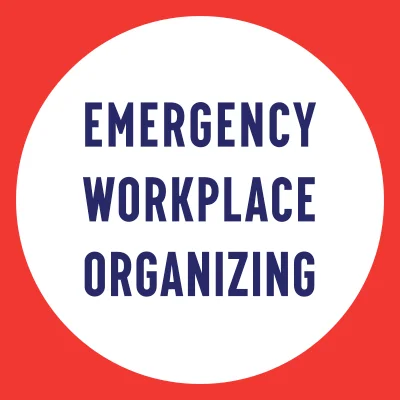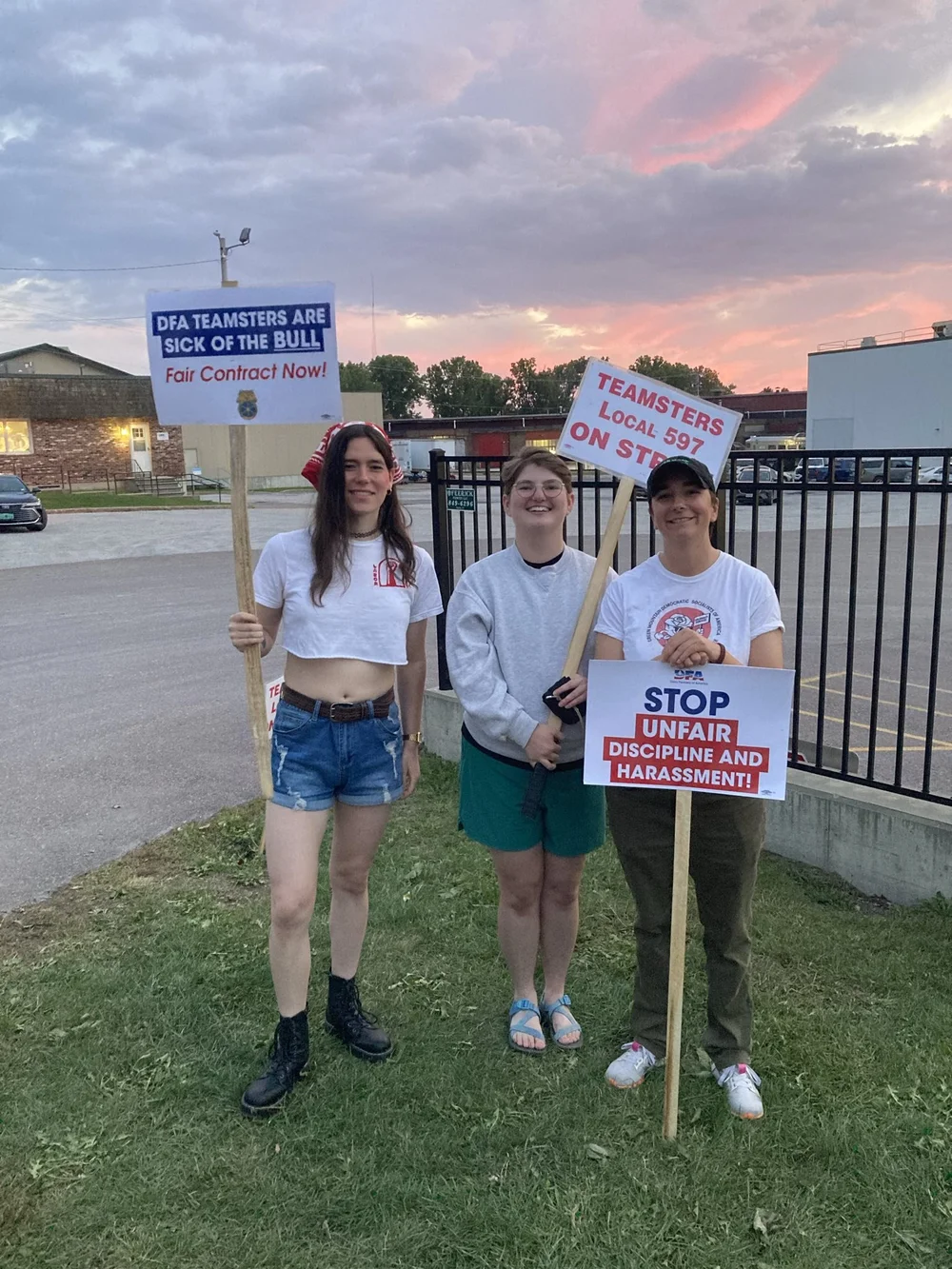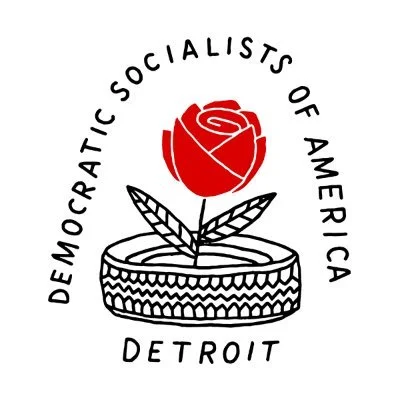


Starbucks Workers in Davis Square Join SBWU; Company Closes Store One Week Later

[[{“value”:”

By: Terence Cawley
SOMERVILLE, MA – The last few weeks have been tumultuous for the workers at the Starbucks store in the Davis Square neighborhood. On Wednesday, September 17, workers voted to join Starbucks Workers United. That made Davis Square the 650th unionized Starbucks store. One week later, on Thursday the 25th, Starbucks announced the imminent closure of hundreds of stores nationwide – including the Davis Square store. By that Saturday the 27th, the store had permanently closed. The new unionized location was gone.
Starbucks shuttered at least twenty locations in Massachusetts in this round of closures, including eight union stores. Besides the Davis Square store, the union store closures include the Harvard Square Starbucks, which unionized in May, and the store at 874 Commonwealth Avenue in Brookline, where the longest strike in Starbucks union history occurred over 64 days in 2022.
Brief History of Starbucks Workers United
Since Starbucks workers in Buffalo, N.Y. started Starbucks Workers United in August 2021, 650 stores (representing over 12,000 workers) have unionized. More than 200 of those stores joined Starbucks Workers United since February 2024. Despite these successes, not one of these stores has so far reached a collective bargaining agreement with the company.
Starbucks Workers United’s demands include changes that will enable more baristas to make a living wage, like higher pay, expanded healthcare benefits and paid leave, and more consistent scheduling. The union is also asking for stronger protections from racial and sexual harassment, as well as the enshrinement of current benefits in a contract so they cannot be revoked by the company later.
Starbucks initially opposed unionization efforts aggressively, leading to over 700 Unfair Labor Practices (ULP) filed against Starbucks with the National Labor Relations Board. The company reached an agreement with Starbucks Workers United in February 2024 to negotiate a “foundational framework” for contracts for union stores. Starbucks then failed to meet its own deadline to agree to this framework by the end of 2024, leading to workers at over 300 Starbucks locations going on strike on Christmas Eve for the largest labor action in company history.
Starbucks Workers United and the company entered mediation in February 2025. While the union has made some progress in contract negotiations, reaching 33 tentative agreements with the company, Starbucks continues to hold out on the workers’ three core demands: increasing worker hours to address understaffing and ensure workers qualify for benefits, increasing take-home pay, and resolving all outstanding ULP charges.
Starbucks Workers United claims on their website that Starbucks could finalize fair union contracts for less than the over $97 million Starbucks CEO Brian Niccol made for four months of work in 2024. Starbucks also covered the cost of Niccol commuting from his home in California to company headquarters in Seattle via private jet.
Organizing at the Davis Square Starbucks
Ben Levin has worked at the Davis Square Starbucks since April 2023. “From the beginning,” he has loved his coworkers. However, when Levin and his partner began planning to have children, he saw how his coworkers with families struggled due to a lack of consistent scheduling, subpar benefits, and low wages, not to mention the high cost of living in the Greater Boston area. Levin reported to Working Mass:
I was like, it would be so cool to be able to keep this job and start a family, and the only way I can see that that would be possible would be to fight back and win some of those things.
Some Starbucks customers had already encouraged Levin and his fellow Davis Square workers to unionize, but workers spent several years organizing the groundwork to reach the point where the store was ready for an election. Levin partially attributes this to the “stigma Starbucks manufactures in the workplace” around unionizing. “I understand why people are scared,” Levin said. “There are very material reasons for that.”
While Levin said management at his store did not engage in active union-busting, they did discourage workers from organizing through what he characterized as “trying to manufacture a sense of divisiveness and fear.” Despite the opposition, Levin found success building support for the union by connecting with his coworkers on a human level, listening to the challenges they faced at work, and providing accurate information about how a union could help with those challenges. According to Levin:
At the end of the day, everyone cares, everyone wants a better workplace. [You just] have to keep shoring up support and reminding folks why we’re in it together.
Levin also found inspiration in the accelerating momentum of the nationwide Starbucks Workers United effort. “It’s important to be connected to a larger movement,” said Levin. “This is a really powerful and kind of explosive labor movement- you know, [Starbucks Workers United] is the fastest-growing unionization effort in modern history.”
Additionally, the Davis Square workers had the support of Julie Langevin, a Starbucks Workers United staff organizer and former barista who has been involved with the union for over three years. She sees significance in the milestone of 650 unionized stores which Starbucks Workers United reached with the Davis Square election victory. Langevin said, on a hopeful note:
Every store that unionizes shows other baristas that they can do it too. 650 is a number some people thought impossible, but to us, it’s the proof that workers know what they’re worth and that they know when they fight, they can win.
Store Closures and What Comes Next
“It was sweet to celebrate,” said Levin. “It’s just hard to think about it not in the context of the closure.”
The official reason given in Starbucks CEO Brian Niccol’s statement is that the stores being closed are “coffeehouses where we’re unable to create the physical environment our customers and partners expect, or where we don’t see a path to financial performance.” In a separate statement, the company denied that unionization impacted which stores they closed. Still, Levin believes that, while Starbucks targeted stores without customer seating (like Harvard Square) and stores with lower revenue (like Davis Square) for closure, a desire to close union stores, particularly newly unionized stores with “the most fired-up workers,” may have been a factor.
While Niccol’s statement claimed that Starbucks would offer workers at closed stores the opportunity to transfer to other stores, as of September 30, Levin and his Davis Square coworkers have yet to receive any such offer. Fortunately, Starbucks Workers United has secured several protections for laid-off union members, including an extra month of health care benefits and the option to decline a transfer offer without losing their severance package.
“For some of us, this is our last week at Starbucks, but we still got to see the real material impact that the union is having,” said Levin. And even in the face of store closures and protracted contract negotiations, Langevin and Levin remain confident that the union will ultimately prevail. As Langevin said:
We have no other choice. Workers can either accept what the company gives them, or fight for a chance at a better life. And every time workers reach out and want to fight, it brings me hope and continued inspiration.
Supporters of Starbucks Workers United can show their solidarity and receive email updates about future actions by signing the No Contract, No Coffee pledge at https://sbworkersunited.org/take-action/. The union and its supporters have been canvassing for these pledges since summer to demonstrate to Starbucks how many customers will not cross the picket line if workers go on strike. To that end, Starbucks Workers United will hold a practice picket outside the Harvard Square Starbucks on Saturday, October 4 from 11am to 1pm.
“I absolutely think that a fire has been lit. We’ve had so many customers come in and express outrage at what’s happening to us, and ask what they can do to support us.”
“We’re escalating to something major,” said Langevin. “This practice picket is just the beginning of us flexing that power to company leadership, and there’s more to come.”
Terence Cawley is a member of Boston DSA.

The post Starbucks Workers in Davis Square Join SBWU; Company Closes Store One Week Later appeared first on Working Mass.
“}]]


Endorsement: Zoelle Lane, Fort Collins Council
Zoelle Lane is running for Fort Collins Council. Zoelle is an immigrant, union member, and renter running to tackle Fort Collins’ cost of living crisis and to empower its residents. One of her goals for office is to raise the minimum wage, which is long overdue!
Zoelle is part of a slate of candidates in the Socialist Cash Takes Out Capitalist Trash fundraising project!


On for Young and Old: How Boston University’s Resident Assistants Pulled Off a Double Strike

[[{“value”:”

By: Stacey Yuen and Alana Edwards, with contributions from Thomas Baker
This article was originally published in Long-Haul Magazine in its Winter 2025 Issue.
In Fall 2024, Boston University’s Resident Assistants (RAs) pulled off a rare, week-long strike in this new corner of the labor movement. Over seven days, Residence Life (ResLife) workers held their weight amid frazzled union staffers, hostile supervisors, and internal fracturing to strike during Fall move-in – a high-leverage period during which tens of thousands of students rely on RAs to move and settle into campus housing, with parents in tow. This was our second strike to win higher stipends, better protections against harassment, and paid health insurance for those not on family plans, in the context of negotiations for our first contract. On September 5, BU threatened to withhold RAs’ compensation, which comes in the form of housing and meals. Workers voted to end the strike shortly after this threat. To the surprise of some of us, BU increased their semesterly stipend offer from $1,000 to $1,700 a few days after the strike ended.
We are two rank-and-file members who helped organize BU RAs’ “Marathon Monday” strike in the Spring and the Fall 2024 move-in strike. As RAs, our job involves looking after the safety and well-being of more than 12,000 campus residents at BU. We work on-call shifts to respond to student emergencies, assist with housing needs, connect residents with resources, and plan community programs. Undergraduate students make up around 85% of our 300-member unit and graduate students account for the rest. Workers are compensated with housing and meal plans, although only half the unit received the latter before our strikes. The unit tends to be staffed by some of the most working-class, housing and food-insecure, and racially diverse students at the university. We are, therefore, relatively young and unversed in our dealings with both management and union. Our status as workers is also complicated by our other relations to the employer, as students and tenants.
In recent time, the “upsurge” of labor organizing in higher education has drawn much attention, along with the university’s exploitation of student debt through tuition and rent.1 Yet the organizing potential for many thousands of residential assistants around the country, who stand uniquely at the nexus of these trends, has been comparatively overlooked. We hope our experience can be instructive for RAs elsewhere.
A YEAR ON THE JOB (STACEY)
In August 2023, I began my two-week RA training program at Boston University. The sessions ran daily from 9am and ended in the evenings, occasionally as late as 10pm. I was 30, but was immediately made to feel 12 again. Our supervisor yelled at us to keep quiet, called us out if we looked at our phones, stared at us if we talked with each other, pulled us aside if we were five minutes late, and policed us into performing a charade of attentiveness during presentations, even as they droned on for hours with few breaks. Graduate RAs (GRAs) like myself, who have some responsibility to supervise and provide additional support to undergraduate RAs, were also roped into acting like their parents. If “our” RAs were not on time for a meeting, we were told, we had to retrieve keys from the office to enter their rooms and bring them down.
On the last day of training, all 300 fatigued and pissed-off RAs were made to participate in a treasure hunt and put on dance and chant performances as part of our “team building.” The audience and judges were our supervisors (primarily university staff) along with other administrators involved in student affairs. There was a fancy buffet, staff promotion announcements, and other such things. It was clear that part of our training involved being habitually infantilized and, for the GRAs, becoming some mix of parents and managers. This dynamic was weaponized against us when we attempted to fight for ourselves as workers.
“The worst is over,” I was told. “The job isn’t actually that difficult.” But, in my first week of duties, I found myself frantically setting up meetings to try and save a coworker’s job. They had not met academic grade requirements in the spring for continuing their RA role and were only informed about their predicament after they were rehired for the fall semester, already in full swing. “If they had told me at the end of spring,” my coworker said, “I could have just taken a summer course to boost my grade and everything would have been fine.” Instead, they were removed from the role and evicted from their on-campus residence with one week’s notice.
These experiences illustrate some of the unique realities of undergraduate labor. Undergraduate workers are “young,” not only in the literal sense, but in terms of how they ought to be treated by management. Managerial truisms like “they do not know what is good for them” infiltrate supervisor-employee relations. At BU, RAs must seek their supervisors’ permission to leave their residences for more than 24 hours even when they are not on call. My coworkers have been denied permission, without explanation, for something as innocent as attending a cousin’s wedding. And so, the pressure to perform obeisance to our supervisors becomes part and parcel of life as an RA.
But many RAs have been working multiple jobs since high school. One told me about a time they had a gun pulled on them while working as a fast-food restaurant manager in their teens; another complained about working under the hot Texas sun for $12 an hour, 12 hours a day, at an amusement park while a full-time high school student. Moreover, the nature of RA work, at its most intense, requires that workers attend to residents in crisis, to violent altercations, and even deaths. In the wake of one tragic student death on campus, my coworkers and I set up emergency discussions about how to respond to our residents and support one another in the face of confusing instructions and administrative oversight that had put workers in unacceptably difficult positions. It was apparent from those discussions that undergraduates’ maturity, wisdom, and workplace savvy are in abundance, whether administrators recognize it or not. But, of course, it’s in management’s interest not to.
“WE NEED TO PROVIDE THAT EDUCATIONAL MOMENT”
For management, ResLife workers’ youth and inexperience were reason enough to dismiss our organizing. We learned that BU was characterizing us as “ungrateful” and “aggressive” at the bargaining table. These complaints about our supposed childishness spilled over into daily interactions with our supervisors.2 RAs made several efforts to meet with supervisors about how RAs themselves understood the negotiations – as a path toward ending food insecurity and the necessity of juggling multiple jobs. We were unable, however, to have this middle layer exert any pressure upward; more often, it came down on us in the form of mounting tension at work. During the strike, some supervisors grew openly disdainful of workers with whom they formerly had friendly and warm relationships.
Ignorance and inexperience were also key tropes in the university’s public messaging. In an interview with the university paper about the administration’s plans to slap room and board charges on striking workers, the Dean of Students stated,
My goal is to educate everybody in the bargaining unit on the effects of withholding labor during negotiations or at any point in their role. We’ve heard from many RAs who are confused about what this means; they’re not getting clear communication. We need to provide that educational moment.3
Unfortunately, there was also a tendency for union staff’s attitudes to resemble management’s. Micromanagement in the form of repeated calling and texting workers to track progress on tasks was common. Behaving like summer camp counselors, staff typically led meetings in ways that resembled a Q&A rather than facilitating discussions among workers.4
STRIKING “MARATHON MONDAY”
In Spring 2024, workers began to feel the need to do something to gain more movement at the bargaining table. The annual drop in staffing over the summer and massive turnover going into the fall semester contributed to this sense of urgency. The only meaningful concession the university had made was to offer meal plans for all workers and RA and GRA stipends of $1,000 and $1,500 per semester, respectively. Prior to contract negotiations, only about half of workers were getting meal plans and a small number were receiving stipends of a few hundred dollars.
BU RAs decided to organize a strike over Boston’s Marathon Monday (“MarMon”) long weekend in mid-April. Apart from the anticipated additional workload (responding to noise complaints, investigating overly raucous parties, booking out keys to residents who lost them, etc.), that weekend was critical because it coincided with the university’s Family and Friends weekend, where ResLife workers take on additional shifts to engage and welcome BU’s visitors and patrons.
With “MarMon” as our target, the union began assessing strike-readiness. Union staff declared that we needed strike commitments from 270 of our 300 members in order to authorize a Strike Authorization Vote (SAV). This high bar was raised further when the staff required us to collect “selfie” photographs from coworkers as proof of their strike readiness and send them to staff, who would then mark those individuals as strike-ready on our wall charts.
The process of collecting these strike-readiness selfies caused several frustrations. First, many RA organizers were confused about the logistics and purpose of the selfies. RAs themselves asked important questions about how we were tracking them, whether they would be publicized, and how they were relevant to the strike. Organizers found it difficult to explain the rationale, making for extremely awkward interactions. The lack of clarity around the process, and more importantly, the hazy analysis of the relationship between the selfies on the one hand and our collective power on the other translated into demoralization and forced us to direct our energy toward sorting these questions out with each other and with union staff. Other essential efforts, like running small group conversations focused on strike preparation, power analysis, and inoculation faded into the background. We graduated from dancing and singing for our supervisors only to send selfies to our union staff.
Some organizers attempted to address the lack of bottom-up organizing and worker segmentation across campus by starting at the “neighborhood” level. ResLife workers are split across seven residential areas, also called “neighborhoods,” that are spread out around BU’s famously long and skinny campus. Workers do not interact across neighborhoods for most of the academic year. Until this point, neighborhood meetings were either poorly attended or nonexistent. This was true for both neighborhoods that relied on union staff’s initiative as well as those that attempted a more bottom-up approach. Three neighborhoods were almost totally disengaged. Meanwhile, attendance at bargaining and collective action team meetings flagged, in part because those meetings often felt uninspiring or inconsequential.
Some rank-and-file organizers began meeting and talking one-on-one and in very small groups with workers from different neighborhoods in an effort to build a core of cross-neighborhood stewards. One priority was engaging “organic leaders” from disengaged neighborhoods. Since we wanted more workers to take ownership of our workplace and union, we began with workers who were less habituated to staff-led decision-making. Within weeks, a new core developed, comprising about eight workers, three of whom were from previously disengaged neighborhoods. We also formed a group of about 15 rank-and-file neighborhood stewards and began sharing and discussing neighborhood organizing strategies and resources on WhatsApp.
Workers had no edit access to their own wall charts and could only leave comments. So we made our own chart, which decoupled strike-readiness from selfie commits. In the second half of March 2024, these rank-and-file leaders started strike assessments, focusing especially on three newly organized neighborhoods where staff had limited reach.
Our approach enabled us to gain traction within certain neighborhoods. As a result, it eventually became necessary to hash out our differences with the advocates of the selfie-based strike readiness plan. This led to an emergency meeting between rank-and-file leaders and the Local president, during which workers attempted to convince staff that we were ready to strike, whatever the selfie metrics indicated. We negotiated over the number of selfies that would trigger a strike authorization, ultimately compromising on a reduction from 270 to 170, or from 90 percent to approximately 56 percent of our bargaining unit.
Unfortunately, in the same meeting, we were less successful in winning over coworkers or staff to the idea of an indefinite strike. The staff proposal for a four-day “warning strike” over MarMon ultimately prevailed, hoping that the threat of a strike would win specific demands like back pay, better training provisions, and having masks in offices. Although unconvinced that this could force such concessions from the university, our new group oriented towards this action as a “practice strike” – i.e. a window to learn BU’s pressure points and tactics, as well as our areas of strength and weakness, in order to organize for an indefinite strike during the move-out window at the end of the semester. Within a mere week, led in large part by a surge in the newly organized neighborhoods, ResLife workers hit 92% assessment, 70% of whom were strike-ready, and another 12% leaning yes. The Local conducted our SAV, which passed comfortably: we were going on strike.
In hindsight, our approach had not adequately prepared for the realities of a strike. Our assessment of strike-readiness had fallen into the trap of getting as many Yes votes as possible at the cost of creating power-building spaces where workers could collectively build the necessary relationships, skills, and structures to navigate high-stress, high-stakes situations. There was no way we could critically discuss and respond to problems that arose in real time.
After the strike, rank-and-filers got together to discuss what we had accomplished, how we fell short, and where we were headed. The strike forced small victories. We began to receive masks at big meetings and our RA training the next academic year was much improved in terms of duration. By summertime, BU also provided air conditioning for all RAs and relocated summer RAs out of the notoriously stuffy rooms at Warren Towers. We had managed to strike roughly 90 percent of assigned shifts over the MarMon weekend. However, this overwhelming success was achieved, in part, by strike-ready workers swapping shifts with less confident workers. This, of course, was only possible because we were not on the long-term strike that we thought was necessary to win.
We also identified the picket line (combined with staff insistence that the strength of our strike could be gleaned from picket attendance) as a site of demoralization, alongside the pervasive feeling of just trying something disruptive and hoping that it might work, rather than formulating a defensible strategy based on a rigorous assessment of our leverage relative to our demands. Workers came away from this “warning” or “practice” strike less, rather than more, unified, coherent, and ready to fight. Our plan to organize for a subsequent indefinite strike was in tatters, and our experience defied the commonplace wisdom of successively escalatory action.
Finally, we reflected on the role played by union staff and considered possible ways of navigating our relationship with them differently in future. We discussed setting boundaries with them and crafted a memorandum that we then signed, presented to, and discussed with staffers. The memo emphasized that workers would maintain full control of our organizing strategy, timelines, goals, wall charts, and data. Staff were directed to refrain from repeatedly calling or texting us.
“I’VE NEVER SEEN THIS MUCH PARTICIPATION IN ALL MY TIME ORGANIZING”
By the end of the four-day MarMon strike, our major contract demands remained unmet and an agreement was nowhere in sight. Though much of the unit had turned over between the Spring and Summer semesters, a small core of committed rank-and-file organizers remained. Restrictive timelines regarding SAVs in the Local’s constitution made the prospect of launching a sanctioned strike incompatible with striking at the point of our highest leverage vis-a-vis the employer: namely, Fall move-in. Our core organizers decided therefore to organize towards a wildcat strike to begin on the first day of Fall semester move-in.5 Fortunately, the intensive RA training in August provided, in addition to much frustration with supervisors, an opportunity for RAs to discuss this plan.
During August’s RA 2024 training, core organizers called a general membership meeting that saw our largest attendance yet, with more than a third of the unit showing up. Importantly, there was a new energy and hunger in the room and this moment felt to workers like a high point in our campaign. In a vote, 94 percent of us agreed to start preparing for a move-in strike by talking with our coworkers who were not present. At the same time, these deliberations revealed concern about striking without support from the Local, as did a follow-up survey, filled by close to 80% of membership. However, the genuine swell of militant energy and collective deliberation from below was not lost on the Local’s staff or officers. Following a second meeting attended by more than half of the membership, one of them said, “I’ve never seen this much participation in all my time organizing.”
The conviction of workers pushing for immediate action even compelled the union to permit a constitutional amendment that would allow an SAV to pass quickly enough that we could strike at least part of move-in. The SAV stipulated that, in order to pass, we would need 80% of the entire unit to vote Yes and it is a testament to this swell of momentum that such an outcome was possible. We cleared this high bar and set out on strike. Here is the reflection of a core undergraduate organizer:
Even after participating in the MarMon strike, striking move-in felt wildly new, exciting, and empowering, although very challenging. The emotional rollercoaster lasted from strike preparations all the way through the strike itself. The morning of the walk-out, my racing heartbeat woke me up before my alarm could. I would regularly remind myself that even though fear and doubt would always seem more valid responses to the decision we were making, I was choosing to strike because I believed in the justice we were seeking, because I knew it was what was right and it would be worth it, and because I committed to myself and my coworkers that I would give it everything I could.
Throughout that day and each that followed, me and my coworkers exerted our collective power, took action, and formed new bonds of comradeship together. We stood by each other while we anxiously waited to be picked up by a strike train. Every chant I sang, every flyer I handed out, and every poster I attempted to put up was part of a larger struggle. I also fought for former coworkers, and every future and current 19-year-old RA who deserved better than the harassment my friends and I should have never faced. I even fought by doing TikTok dances in our ResLife polos with a friend I’d made just days before, in the most visible spot on campus, when we were too frustrated with each other to make another rushed decision.
We won the battles we faced simultaneously as individuals and collectively. We won as we met each other’s eyes when passing on the picket line. We won as security guards raised their fists and cheered with us as we walked out of campus’s largest dorm. And we won as students, parents, faculty and staff members, community members and leaders expressed their support through every email, tweet, and repost, through loud shouts of encouragement, through the moments they spent listening and calling on our behalf, even the smallest gestures of solidarity.
Notwithstanding such tireless efforts, confidence in the strike had begun to erode with the many sudden turns and lurches in the lead-up. Not a few who had previously agreed to strike pulled out. This was partly due to misinformation from Local staff, who were trying to rework restrictive internal policies to support our strike (we are the first RA unit in the Local). Core organizers were also under great pressure to make high-stakes decisions within a compressed time frame and tried to do so democratically. But the high tempo of informational and procedural changes, charged emotions, and clunky mass decision-making wore us out. Another challenge was that a large proportion of workers were brand new to the job, much less the union.
In the days that followed, ResLife workers went on what turned out to be a minority strike, with uneven numbers of workers withholding labor across neighborhoods during their move-in shifts. After the time lost in the back-and-forth with the Local, the strike ended up beginning on the fourth day of the week-long move-in and continued beyond it. Seven days into the strike, the university threatened to impose room and board charges for striking workers. Organizers, scrambling to respond, tried to assuage fears by saying workers would be more protected if more people struck. This was the wrong approach, especially as numbers dropped, because it divested workers of a sense of their own power when striking by sidelining genuine questions of strategy. It instead encouraged workers to find security in abstract metrics rather than to build structures, processes, and resources that would support a long-haul strike, one that might even have been powerful if concentrated in specific neighborhoods, despite relatively low overall numbers. There was widespread demoralization when some coworkers pulled out of the strike, creating a domino effect and the eventual collapse of the strike.
CONCLUSION
To workers’ surprise, BU increased their semesterly stipend offer from $1,000 to $1,700 after the fall move-in strike ended, despite its weaknesses. We think that the chaos and visibility of the strike meant that management, far from being unbothered, felt relieved that things did not get as disruptive as they might have. The many last-minute emergency meetings called by middle management, as well as the outbursts of various managers, suggested a workplace in panic. Although many of our shifts were successfully scabbed, our strikes caused logistical headaches for management because we do essential university labor in housing safely some 12,000 residents and patrons, who each pay upwards of $16,000 annually in room and board.
Importantly, both ResLife strikes occurred alongside a militant long strike undertaken by the university’s graduate workers. From March to October 2024, the BU Graduate Workers Union (BUGWU) ran the longest graduate strike in US history, pushing for demands such as a cost-of-living-adjustment tied to the rental market. When ResLife workers hit the picket, the university was also facing the prospect of another semester with BUGWU workers on strike. It is conceivable that the university, sensing this new worker militancy from RAs on the ground, was eager to settle the ResLife contract to foreclose the possibility of another strike like BUGWU’s. Less than a month after the RAs reached a tentative agreement, BU also made unusually quick concessions in a clear effort to reach a contract with BUGWU and end the strike. Their contract was eventually ratified in October.
Despite the persistent and frustrating condescension by our employer and, at least initially, our union staff, budding militancy within BU’s ResLife union delivered us to two strikes that pushed our Local and won us materially significant pay and compensation increases from the boss, as well as stronger protections and a relatively streamlined training program. From where we sit, the collective deliberation by rank-and-file workers, which dramatically changed the course of our campaign, was the real “educational moment,” impressing upon management and our Local staff certain lessons they won’t easily forget. After the strike, a staffer said to one of us that getting ResLife representation on the Local’s chapter executive board was critical to reforming the Local’s existing policies – clear recognition that we had something to teach the “old timers” as well.
Building up and layering this kind of militancy in both graduate and RA unions within the same university, in order to strategize and move in tandem, is a clear next step. While the connections between these struggles were glimpsed at BU, where some workers are members of both BUGWU and ResLife and where we share the same Local, we cannot claim to have fully developed the potential leverage of joint solidarity against the employer. This is no simple prospect, but appears newly in reach in the aftermath of our respective struggles, and might be pursued wherever undergrad and grad workers are in motion, whatever their organizational affiliation.
1 – See Notes From Below, Correspondences from the Upsurge, August 28, 2023, available at https://notesfrombelow.org/issue/correspondences-upsurge; Coalition Against Campus Debt, Lend and Rule: Fighting the Shadow Financialization of Public Universities (Philadelphia: Common Notions, 2024).
2 – For context, the university’s bargaining team included managers above our direct supervisor, who would receive reports on bargaining from above. Our direct supervisors, therefore, did not have direct access to bargaining sessions, and as a result, their understanding of negotiations was shaped heavily by management, especially as they were unwilling to consider our perspectives seriously.
3 – See Rich Barlow, “BU to Suspend Free Room and Meals for Striking Student RAs,” BU Today, September 5, 2024, https://www.bu.edu/articles/2024/suspended-free-room-and-meals-for-striking-student-ras.
4 – A comrade from the graduate worker union who sat in at a staff-led ResLife union meeting said he had not observed such condescension in a long time and felt he was in middle school again.
5 – The strike would be a “wildcat” insofar as we expected that it would not be authorized by the Local, even if it might be legally protected as concerted action under Article 7 of the NLRA, given that our demands were clearly “mandatory” subjects of bargaining and, this being our first contract, we had no pre-existing “no-strikes” provisions.
The post On for Young and Old: How Boston University’s Resident Assistants Pulled Off a Double Strike appeared first on Working Mass.
“}]]


DSA is an Anti-Zionist Organization!
Author: Megan R
One of the most contentious and confusing debate blocks at the 2025 Convention was the international section, specifically deliberation on the resolution titled For a Fighting Anti-Zionist DSA (R22) and the agendized amendment titled Align With the BDS Movement (R22-A01).
For context to anyone who is not plugged into DSA’s founding story:
“Whereas, and antithetical to the DSA’s contemporary principles and policies, DSA’s founding merger was heavily predicated on ensuring that the DSA would uphold DSOC’s position of supporting continued American aid for Israel’s Zionist colonial project, as explicitly noted in our organization’s founding merger documents (e.g., Points of Political Unity) and by Michael Harrington himself in his autobiography;”
– Anti-Zionist Resolution (#12), which was referred to the National Political Committee (NPC) from the 2023 National Convention
Members of DSA have been organizing within our democratic structures to course correct since the very beginning and that effort has been documented since at least 2019 (see passed resolution #35, speaker lineup). Organizers who are passionate about Palestinian liberation have devoted themselves to the steady and demanding work of changing minds of our comrades in DSA. We have come a long way as an organization in solidarity with our Palestinian comrades, despite what external reporters would like to imply. This progress is laid out neatly in the “whereas” clauses of R22 which details not only the statements made over the last few years, but also the working groups created, campaigns run, and strategies defined.
Much of what we passed during this convention will support our Palestine work, such as the formal commitment to the “independent party surrogate” electoral strategy. It would have been great to also pass the Electoral Discipline resolution, which would reduce the damage that could be caused by chapter electoral program fiefdoms by providing a framework for chapters, but that will resurface in 2027!
The R22 Anti-Zionist resolution in particular was the culmination of more than two years of dedicated effort to confirm our commitment to being an explicitly anti-Zionist organization.
“Make DSA an Anti-Zionist Organization in Principle and Praxis” was originally brought forward for consideration at the 2023 National Convention but was referred to the NPC for a decision. In the last two years, many chapters have voted to adopt variations of this resolution locally, including our own chapter! (See the text differences in both resolutions here.)
“[Since] March 25th 2025, 54 DSA chapters representing over 30,000 DSA members have passed their own versions of the “Make DSA an Anti-Zionist Organization in Principle and Praxis” resolution, enshrining locally both membership expectations and electoral endorsement conditions of principled anti-Zionism that has provided a necessary, material counter-weight to the Zionist lobby for progressives running for local office.”
– For a Fighting Anti-Zionist DSA, which passed at the 2025 National Convention
Fun Fact: Our 2023 chapter delegation had a fuzzier political divide on this topic (4-2-2 split for delegates, 8-3-2 for candidates) than our 2025 chapter delegation did (7-1-4 split for delegates, 10-1-4 for candidates), bringing our delegate candidate support for Anti-Zionist measures up to 90% from 72% just two years ago. This is a testament to our political development as a chapter!
In the intervening years, alongside the local approach, organizers for an Anti-Zionist DSA strengthened the resolution by building a positive vision of what we can and should be doing as an organization to support Palestine liberation.

During convention, there were a lot of myths being circulated, most notably a flyer distributed by a non disclosed political faction.
Fortunately for our comrades in the Springs of Revolution faction who wrote R22, and for DSA’s external reputation on Palestine, deliberation on R22 and its amendment was split across two days. This gave the resolutions authors and Palestine organizers a chance to correct the rumors that had been so carelessly and cynically spread the day before with the distribution of a fact sheet.
Comparing the Options
In order to demystify the text of R22 as it compares to our local Anti-Zionist resolution and clarify what the amendment would have changed if passed, we’ve compiled a side-by-side comparison below, along with links to the full text for both, highlighting key differences. (This comparison will focus on the “resolved” clauses of the texts, which constitutes the binding portion of a resolution or amendment.)
| Cleveland’s Anti-Zionist Resolution | National Anti-Zionist Resolution (R22) | R22-A01 (p. 247 in Compendium) |
| Opening “resolved” clause: “Therefore, be it resolved, the Cleveland DSA chapter denounces the organization’sZionist roots and reaffirms its commitment to being an anti-racist, anti-imperialist organization by explicitly committing to being an anti-Zionist chapter– in both principle and praxis;” |
Opening “resolved” clause: “Therefore, be it resolved, that DSA shall make organizing in solidarity with the Palestinian cause a priority until Palestine is free, unequivocally affirming our commitment to ‘al-Thawabit’, the principles originally set by the Palestinian National Council in 1977 and repeatedly reaffirmed since, which are the Palestinian people’s right to resistance, the Palestinian right to self-determination, the recognition of Jerusalem as the capital of Palestine, and the right of Palestinian refugees to return to their homeland from the river to the sea;” |
First edit, which comes off as a hostile amendment because it seems to negate all following text: “proactively aligning all national DSA candidates with the organization’s previously established expectations |
| Red lines for endorsed electoral candidates (identical): – Public support of the BDS movement. – Refrain from any/all affiliation with the Israeli government or Zionist lobby groups (examples provided). – Pledge to oppose legislation that harms Palestinians (examples provided). – Pledge to support legislation that supports Palestinian liberation (examples provided). |
Red lines for endorsed electoral candidates (identical): – Public support of the BDS movement. – Refrain from any/all affiliation with the Israeli government or Zionist lobby groups (examples provided). – Pledge to oppose legislation that harms Palestinians (examples provided). – Pledge to support legislation that supports Palestinian liberation (examples provided). |
Removes red lines for candidates with the following edits: – Changes all “shall”s to “may” in the text related to candidate red lines. – Inserts carveouts for local chapters to continue to endorse candidates who do not meet our standards on Palestine. |
| Inclusion of red lines in endorsement questionnaire: “our local chapter’s candidate questionnaires will include a question that inquires about the candidate’s position on BDS;” |
Inclusion of red lines in endorsement questionnaire: “any candidate questionnaires used to determine national and local endorsements must inquire about the candidateʼs position on BDS and should include further scrutiny on the candidate’s commitment to Palestinian liberation;” |
N/A – see above |
| How red lines are enforced: “potential candidates who cannot commit to the aforementioned basic expectations will be disqualified from endorsement by the Cleveland DSA at every level” |
How red lines are enforced: “potential candidates who cannot commit to the aforementioned basic expectations shall be deemed, by the National Electoral Commission as well as any relevant approving bodies at the chapter level, as ineligible for endorsement by DSA or a DSA chapter;” |
N/A – see above |
| Education of endorsed candidates: “upon receiving fair and ample opportunity for education about the Palestinian struggle for liberation, endorsed candidates who do not commit to the aforementioned basic expectations will have their Cleveland DSA endorsements swiftly revoked;” |
Education of endorsed candidates: “upon receiving fair and ample opportunity for education about the Palestinian struggle for liberation, endorsed candidates who fail to continue to uphold the aforementioned basic expectations after being endorsed and/or taking office, shall have their DSA endorsements revoked locally and/or nationally as applicable;” |
N/A – see above |
| Coalition Partners & Strategy: – Collaborate on educational materials for endorsed candidates alongside “trusted Palestine Solidarity movement partners in the grassroots (e.g., Palestinian Youth Movement).” |
Coalition Partners & Strategy: – Directing the Palestine Subcommittee of the DSA’s International Committee to expand the reach of the Stop Fueling Genocide Campaign. – Endorsement of, and outreach to support the Palestine Solidarity Working Group’s No Appetite For Apartheid campaign (Note: PSWG is a coalition partner, not a body within DSA). – Endorsement of the Palestinian Youth Movement’s Mask Off Maersk campaign. – Commitment to build labor support for an arms embargo campaign through the Labor for an Arms Embargo working group within the NLC, taking inspiration from Mask Off Maersk and No Harbor for Genocide. – Commits our organization to convene an Arms Embargo Organizing Committee, preferencing members who have coalition relationships or have participated in efforts such as the Arab Resource & Organizing Center’s Block the Boat project (which is also referenced on the BDS Movement website). – Allocates IC Palestine Subcommittee and NEC support to chapters working on ballot initiatives based on the International Apartheid-Free Community Campaign. |
Coalition Partners & Strategy: – Removes all references to our valuable coalition partner, the Palestine Solidarity Working Group. – Removes the endorsement of coalition partner PSWD’s No Appetite For Apartheid campaign and replaces it with endorsement of “the BDS movement’s boycott of Israeli wine and produce.” – Narrows the language to encourage chapter-level campaigns “such as the Boycott War Profiteers’ campaign against the sale of wine from the Israeli Occupied Golan Heights at PCC Community Markets.” – Softens language around encouraging chapter campaign development with edits such as replacing “identify” with “consider.”- |
| Expectations for Members: Automatic expulsion of members who: 1. have consistently and publicly opposed BDS and Palestine, even after receiving fair and ample opportunity for education about the Palestinian struggle for liberation, 2. be currently affiliated with the Israeli government or any Zionist lobby group(s), or 3. have provided material aid to Israel. |
Expectations for Members: Upon a two-thirds NPC vote, expulsion of members who: 1. have consistently and publicly opposed BDS and the Palestinian cause (examples given), even after receiving fair and ample opportunity for education about the Palestinian struggle for liberation, 2. be currently affiliated with the Israeli government or any Zionist lobby group(s) (examples given), or 3. have knowingly provided material aid to Israel (examples given). |
Expectations for Members: Entirely removes this section. |
| Member Reinstatement: Members are considered for reinstatement annually if the general body votes to accept their reinstatement on the basis of a written statement provided. |
Member Reinstatement: Not specified, but the expulsion is not automatic. |
N/A – see above |
Read my speech against R22-A01 delivered on the Convention floor!
The For a Fighting Anti-Zionist DSA resolution expanded our organizational support for Palestine beyond these red line additions. The end of the Standards and Orientation section, a positive vision is laid out for work we engage in as an organization:
Be it resolved, that DSA shall continue to organize chapters and national bodies to act as meaningful partners within the Palestine solidarity movement, prioritizing campaigns and organizing approaches that:
- Directly undermine material support for Israel, respond to priorities identified by the Palestinian solidarity movement, and correspond with strategic organizing sectors where DSA is well-positioned to contribute (e.g. logistics and higher education);
- Build an organized mass base of support for Palestine and engage a range of political and mass organizations, communities, and economic sectors, thus bringing working-class people together through joint struggle and strengthening our local and national coalitions, particularly with Palestinian-led organizations;
Protect our movement and build resilience against state and Zionist repression;
– For a Fighting Anti-Zionist DSA
Following that section is an entire section dedicated to coalition work, referencing coalition partners (included in the middle column in the table above) and identifying where new democratic decision-making bodies must be formed to succeed in the work ahead of us.
The disinformation being widely circulated during convention, combined with the misleadingly named amendment led to tension and confusion among the delegation. Ultimately the debate concluded in a close passing vote of 675 (56.3%) to 524 (43.7%). We would have liked to see a more comfortable margin like a supermajority (60%) or two-thirds support, but given the situation we understand how voters were misled.
We are proud that DSA has rejected its founder’s Zionist politics and are hopeful about moving forward to support Palestine with these promising campaigns and coalition partners.
The post DSA is an Anti-Zionist Organization! appeared first on Democratic Socialists of America.


How to organize a retail union
Retail workers often face some of the worst trends in employment, but they're uniquely positioned to put pressure on their bosses to get what they deserve.
The post How to organize a retail union appeared first on EWOC.


The Vermont Socialist - GMDSA newsletter (9/30/25): We go up together, or we go down together
Thanks to all who attended the Labor Day rally in Burlington, one of countless major protests across the country on Sept 1. We were proud to stand side-by-side with so many unions and activist organizations demanding an end to America's oligarchy.
Vermont's labor movement is growing more powerful, unified, and assertive. Right now, in St. Albans, workers want their milk money.
They also want shorter workdays and better health and retirement plans. Last week, members of Teamsters Local 597 went on strike against their employer, the Dairy Farmers of America. The processing plant, which supplies Cabot and Ben & Jerry's, brought in scabs.
If you can, please show your solidarity with the workers, as several Green Mountain Democratic Socialists already have, by joining the 24/7 picket line at 140 Federal St., St. Albans City, VT 05478. You can even ask them about donating to their strike fund.

Sept. 1 in Burlington

Sept. 27 in St. Albans
And if you want to help build working-class militancy across the country, join DSA. In Vermont and everywhere else, we are fighting to organize workplaces, win elections, and advance a better world for all.
With that in mind, please consider marking your calendar for our next general meeting (10/11). Details below.
GMDSA MEETINGS AND EVENTS
🚲 Our Urbanism Committee will meet on Monday, Oct. 6, at 6 p.m. on Zoom.
🔨 Talk about your job and learn about shop-floor organizing from peers at Workers' Circle (co-hosted by the Green Mountain IWW) on the second and fourth Wednesdays of each month, including Oct. 8, at 6 p.m. at Migrant Justice (179 S. Winooski Ave., Burlington).
🤝 GMDSA's East and West branches will come together for another general meeting on Saturday, Oct. 11 at 11 a.m. at Burlington's Fletcher Free Library (235 College St.), where we'll continue last month's discussion about forming a chapter-wide priority campaign for 2026. Newcomers can show up at 10 a.m. for an optional orientation.
🧑🏭 Our Labor Committee will meet on Monday, Oct. 13, at 6 p.m. on Zoom.
🗳️ The next meeting of our Electoral Committee will take place on Wednesday, Oct. 15, at 6 p.m. on Zoom.
👋 Find out how you can help our Membership Committee improve recruitment and involvement in our chapter on Wednesday, Oct. 29, at 6 p.m. on Zoom.
STATE AND LOCAL NEWS
📰 Striking school bus drivers in Windham County returned to work, subsequently ratifying a new union contract.
📰 A Burlington musician has launched a campaign to become Chittenden County sheriff on a promise to refuse to carry out unjust eviction orders.
COMMUNITY FLYERS




Beyond the Liberal Mirage: Why American Politics Is a Closed Loop
By: Rodney Coopwood

The Illusion of Choice
What Americans call political diversity is actually ideological uniformity. Turn on any news channel, scroll through any political debate, and you’ll see the same tired performance: conservatives versus liberals, Republicans versus Democrats, each side convinced they represent fundamentally different worldviews. But here’s what I’ve come to understand as a socialist looking at this spectacle from the outside — they’re all playing variations of the same tune.
Conservatives, liberals, and even libertarians aren’t offering different philosophical frameworks. They’re offering different flavors of the same ice cream: liberalism. The marketing makes them seem distinct, even opposed, but strip away the branding and you find they all believe in the same core values — just different approaches to achieving them.
This confusion runs so deep that when progressives push for reforms like universal healthcare or wealth taxes, they get labeled as “radical leftists” when they’re actually just trying to make the existing liberal-capitalist system function closer to its stated ideals. True leftist positions — like worker ownership of the means of production or democratic economic planning — don’t even register in mainstream political discourse because they fall outside the artificially constrained liberal framework that defines America’s political vocabulary.
Unmasking the Liberal Consensus
At their very core, conservatives, liberals, and libertarians all operate within the classical liberal tradition that emerged from the Enlightenment in the eighteenth century. They all accept:
- Individual rights as the foundation of society
- Private property as sacred and natural
- Market relations as the default way of organizing economic life
- Constitutional government with checks and balances
- The basic legitimacy of democratic institutions (though they may disagree on their scope)
The differences people get so heated about are really just different emphases within this shared framework. Conservatives might say they want minimal government interference in the economy while liberals want more regulation, but both accept that the economy should be organized around private ownership and market exchange. Libertarians take classical liberalism to its logical extreme, but they’re still working within the same philosophical boundaries.
When I say this is about marketing, I don’t mean the policy differences are trivial — they have real impacts on people’s lives. What I mean is that the ideological packaging makes these tactical disagreements appear to be fundamental philosophical divisions when they’re really just different management styles for the same basic system.
Libertarianism perfectly illustrates this point. Libertarians present themselves as radically different from both conservatives and liberals, advocating for minimal government and maximum individual freedom. But libertarianism is actually what you get when you push liberal principles of individual rights and limited government as far as they can go while still maintaining private property and market relations. The libertarian’s “radical” position of eliminating most government functions isn’t a departure from liberalism; it’s liberalism without the moderating influences that other liberals accept as necessary to manage capitalism’s contradictions. This is why libertarianism sits even further right than conservatism — conservatives at least accept some government intervention as necessary, while libertarians want to strip it down to almost nothing.
Here’s where American political discourse gets it fundamentally wrong: liberalism isn’t the “left” — it’s the center of the political spectrum. In mainstream American conversation, “liberal” gets treated as synonymous with “left-wing,” but this is a profound misunderstanding that distorts our entire political vocabulary.
The real political spectrum runs like this: To the left of the liberal center, you have progressivism (what Americans often mistakenly call “liberalism”), then socialism, then communism, then anarchism. To the right of the liberal center, you have conservatism, then libertarianism, then far-right extremism.
But American discourse compresses this entire range into a false binary where “liberal” means left and “conservative” means right, completely erasing actual left-wing positions from the conversation. When Americans say someone is “liberal,” they’re usually describing what should properly be called progressive — someone who wants to reform the liberal system to make it work better, not someone who wants to replace it entirely.
This linguistic confusion isn’t accidental. It serves to make the liberal framework appear to encompass the full range of legitimate political thought, when in reality it represents just the center position with some variations to either side.
The Structural Contradiction
Here’s where it gets interesting from a theoretical standpoint. Capitalism developed as a purely economic system focused on market relations and private ownership. But any economic system needs a political and social framework to sustain it, and liberalism provided that framework for capitalism.
The problem is that these two systems have contradictory logics. Liberalism promises political equality — the idea that all individuals have equal rights and equal say in democratic governance. But capitalism requires economic inequality to function. Someone has to own the means of production, someone else has to sell their labor. Capital needs to accumulate, which means wealth concentrates. The system literally cannot work without creating and maintaining class divisions.
This isn’t some unintended side effect –- it’s structural. Political theorist and historian Roy Casagrande describes how liberalism essentially became capitalism’s philosophical framework, providing the ideological justification for a system that contradicts liberalism’s own stated values.
Even early Enlightenment thinkers who developed liberal theory recognized this tension. They understood that capitalism’s tendency toward inequality could undermine political equality, but they believed this could be managed through institutions and reforms rather than by questioning the economic system itself.
The Evidence: When Theory Meets Reality
This contradiction isn’t just theoretical — it plays out in concrete ways that affect real people’s lives.
Black Americans provide the clearest example of how formal political equality coexists with systematic economic exclusion. Despite decades of civil rights legislation, anti-discrimination laws, and diversity initiatives –- all liberal solutions — the racial wealth gap has barely budged. Median Black family wealth remains about one-tenth that of white families. This isn’t because liberal reforms haven’t been implemented, but because they address symptoms while leaving untouched the underlying system that created and maintains these disparities.
The caste system that affects Black Americans operates alongside the class system. When economic downturns happen, Black Americans face distinct and often disproportionate impacts not just because of class position but because of how race and class interact under racial capitalism. Liberal frameworks struggle to address this because they’re designed to treat race and class as separate issues rather than understanding how they’re systematically intertwined.
Native Americans face even starker contradictions. They’re simultaneously sovereign nations and colonial subjects, with formal treaty rights that exist alongside ongoing land theft and resource extraction. The reservation system creates a form of internal colonialism that liberal political theory can’t even properly name, let alone address. How do you reconcile individual property rights –- a cornerstone of liberalism — with collective indigenous sovereignty and traditional land use practices? You can’t, which is why liberal solutions consistently fail to address the root issues.
Latino Americans demonstrate how immigration status creates tiered citizenship that serves capital’s need for exploitable labor. Some have formal rights while others are deliberately kept in precarious legal positions that make them more vulnerable to exploitation. This isn’t a policy oversight — it’s exactly what the economic system requires to maintain cheap labor pools.
Even European social democratic models, often held up as examples of successful liberal reform, reveal these same fundamental contradictions. Sweden’s domestic equality coexists with arms exports to authoritarian regimes. Germany’s strong worker protections rely on exploiting Southern European labor through EU economic structures. The welfare state ameliorates capitalism’s worst effects domestically while often intensifying exploitation elsewhere.
The Progressive Trap
Here’s what’s particularly revealing: every time progressives push for reforms to address inequality, they’re essentially admitting that capitalism doesn’t naturally produce the outcomes liberalism promises.
Universal healthcare? That’s because market-based healthcare creates inequality. Strong labor protections? Because unregulated capitalism exploits workers. Wealth taxes? Because capitalism concentrates wealth. Affirmative action? Because “merit-based” systems reproduce existing inequalities.
Each progressive reform is an acknowledgment that the economic system undermines the political ideals. The more adjustments liberals have to make to capitalism to achieve their stated goals of equality and freedom, the more they’re proving that socialism’s analysis was correct — that you can’t have genuine political equality while maintaining private ownership of the means of production.
This is why liberal reforms, no matter how well-intentioned, keep failing to address root causes. They’re trying to solve systemic problems with tools provided by the same system that created those problems. It’s like trying to fix a broken foundation by rearranging the furniture.
Beyond the Liberal Horizon
Understanding this helps explain why American political discourse feels so constrained and circular. When both major parties operate within the same fundamental framework, when the boundaries of “realistic” policy are drawn by that framework’s limitations, genuine alternatives become literally unthinkable within mainstream political conversation.
Socialism offers something different because it addresses both the economic system and its supporting political structures. Instead of trying to manage capitalism’s contradictions, it proposes replacing the system that creates those contradictions in the first place. Worker ownership of the means of production. Democratic planning of economic priorities. An economic system designed to serve human needs rather than accumulate capital.
This isn’t utopian thinking — it’s practical recognition that the problems liberalism struggles to solve are inherent to the economic system liberalism was designed to support.
Breaking the Frame
The first step toward real political alternatives is recognizing how narrow the current frame actually is. What gets presented as the full spectrum of political possibility is really just different management strategies for the same basic arrangement of economic and political power.
Once you see this, a lot of things start making sense. Why Democrats and Republicans seem to agree on so much when it comes to fundamental economic structures. Why reforms that sound transformative end up changing so little. Why the same problems keep recurring regardless of which party is in power.
We live in a liberal Enlightenment society with capitalism as its economic model. Until we’re willing to question that framework itself, we’ll keep having the same debates, implementing the same types of solutions, and wondering why the same problems persist.
The real political spectrum is much broader than American discourse suggests. It’s time we started acting like it.
This article represents the opinion of the author and does not necessarily represent the views of The Detroit Socialist or Metro Detroit DSA as a whole.
Beyond the Liberal Mirage: Why American Politics Is a Closed Loop was originally published in The Detroit Socialist on Medium, where people are continuing the conversation by highlighting and responding to this story.



